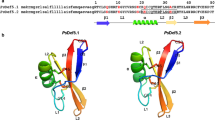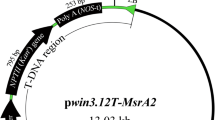Abstract
Plant defense against disease is a complex multistage system involving initial recognition of the invading pathogen, signal transduction and activation of specialized genes. An important role in pathogen deterrence belongs to so-called plant defense peptides, small polypeptide molecules that present antimicrobial properties. Using multidimensional liquid chromatography, we isolated a novel antifungal peptide named Sm-AMP-X (33 residues) from the common chickweed (Stellaria media) seeds. The peptide sequence shows no homology to any previously described proteins. The peculiar cysteine arrangement (C1X3C2XnC3X3C4), however, allocates Sm-AMP-X to the recently acknowledged α-hairpinin family of plant defense peptides that share the helix-loop-helix fold stabilized by two disulfide bridges C1–C4 and C2–C3. Sm-AMP-X exhibits high broad-spectrum activity against fungal phytopathogens. We further showed that the N- and C-terminal “tail” regions of the peptide are important for both its structure and activity. The truncated variants Sm-AMP-X1 with both disulfide bonds preserved and Sm-AMP-X2 with only the internal S–S-bond left were progressively less active against fungi and presented largely disordered structure as opposed to the predominantly helical conformation of the full-length antifungal peptide. cDNA and gene cloning revealed that Sm-AMP-X is processed from a unique multimodular precursor protein that contains as many as 12 tandem repeats of α-hairpinin-like peptides. Structure of the sm-amp-x gene and two related pseudogenes sm-amp-x-ψ1 and sm-amp-x-ψ2 allows tracing the evolutionary scenario that led to generation of such a sophisticated precursor protein. Sm-AMP-X is a new promising candidate for engineering disease resistance in plants.




Similar content being viewed by others
References
Andreev YA, Kozlov SA, Vassilevski AA, Grishin EV (2010) Cyanogen bromide cleavage of proteins in salt and buffer solutions. Anal Biochem 407(1):144–146
Atkinson AH, Heath RL, Simpson RJ, Clarke AE, Anderson MA (1993) Proteinase inhibitors in Nicotiana alata stigmas are derived from a precursor protein which is processed into five homologous inhibitors. Plant Cell 5(2):203–213
Baker MJ, Mooga VP, Guiard B, Langer T, Ryan MT, Stojanovski D (2012) Impaired folding of the mitochondrial small TIM chaperones induces clearance by the i-AAA protease. J Mol Biol 424(5):227–239
Benson G (1999) Tandem repeats finder: a program to analyze DNA sequences. Nucleic Acids Res 27(2):573–580
Boyd PM, Barnaby N, Tan-Wilson A, Wilson KA (2002) Cleavage specificity of the subtilisin-like protease C1 from soybean. Biochim Biophys Acta 1596(2):269–282
Broekaert WF, Terras FRG, Cammue BPA, Vanderleyden J (1990) An automated quantitative assay for fungal growth-inhibition. FEMS Microbiol Lett 69(1–2):55–59
Casteels P, Ampe C, Jacobs F, Tempst P (1993) Functional and chemical characterization of Hymenoptaecin, an antibacterial polypeptide that is infection-inducible in the honeybee (Apis mellifera). J Biol Chem 268(10):7044–7054
Coffeen WC, Wolpert TJ (2004) Purification and characterization of serine proteases that exhibit caspase-like activity and are associated with programmed cell death in Avena sativa. Plant Cell 16(4):857–873
Conners R, Konarev AV, Forsyth J, Lovegrove A, Marsh J, Joseph-Horne T, Shewry P, Brady RL (2007) An unusual helix-turn-helix protease inhibitory motif in a novel trypsin inhibitor from seeds of Veronica (Veronica hederifolia L.). J Biol Chem 282(38):27760–27768
Darvill AG (1984) Phytoalexins and their elicitors: a defense against microbial infection in plants. Annu Rev Plant Physiol 35:243–275
Duvick JP, Rood T, Rao AG, Marshak DR (1992) Purification and characterization of a novel antimicrobial peptide from maize (Zea mays L.) kernels. J Biol Chem 267(26):18814–18820
Egorov TA, Odintsova TI, Pukhalsky VA, Grishin EV (2005) Diversity of wheat anti-microbial peptides. Peptides 26(11):2064–2073
Garcia-Olmedo F, Molina A, Alamillo JM, Rodriguez-Palenzuela P (1998) Plant defense peptides. Biopolymers 47(6):479–491
Garcia-Olmedo F, Rodriguez-Palenzuela P, Molina A, Alamillo JM, Lopez-Solanilla E, Berrocal-Lobo M, Poza-Carrion C (2001) Antibiotic activities of peptides, hydrogen peroxide and peroxynitrite in plant defence. FEBS Lett 498(2–3):219–222
Heath RL, Barton PA, Simpson RJ, Reid GE, Lim G, Anderson MA (1995) Characterization of the protease processing sites in a multidomain proteinase inhibitor precursor from Nicotiana alata. Eur J Biochem 230(1):250–257
Herbst R, Marciano-Cabral F, Leippe M (2004) Antimicrobial and pore-forming peptides of free-living and potentially highly pathogenic Naegleria fowleri are released from the same precursor molecule. J Biol Chem 279(25):25955–25958
Janzik I, Macheroux P, Amrhein N, Schaller A (2000) LeSBT1, a subtilase from tomato plants. Overexpression in insect cells, purification, and characterization. J Biol Chem 275(7):5193–5199
Jennings C, West J, Waine C, Craik D, Anderson M (2001) Biosynthesis and insecticidal properties of plant cyclotides: the cyclic knotted proteins from Oldenlandia affinis. Proc Natl Acad Sci USA 98(19):10614–10619
Kozlov SA, Vassilevski AA, Feofanov AV, Surovoy AY, Karpunin DV, Grishin EV (2006) Latarcins, antimicrobial and cytolytic peptides from the venom of the spider Lachesana tarabaevi (Zodariidae) that exemplify biomolecular diversity. J Biol Chem 281(30):20983–20992
Landon C, Barbault F, Legrain M, Guenneugues M, Vovelle F (2008) Rational design of peptides active against the gram positive bacteria Staphylococcus aureus. Proteins 72(1):229–239
LaVallie ER, DiBlasio EA, Kovacic S, Grant KL, Schendel PF, McCoy JM (1993) A thioredoxin gene fusion expression system that circumvents inclusion body formation in the E. coli cytoplasm. Biotechnology (NY) 11(2):187–193
Lay FT, Anderson MA (2005) Defensins–components of the innate immune system in plants. Curr Protein Pept Sci 6(1):85–101
Li F, Yang XX, Xia HC, Zeng R, Hu WG, Li Z, Zhang ZC (2003) Purification and characterization of Luffin P1, a ribosome-inactivating peptide from the seeds of Luffa cylindrica. Peptides 24(6):799–805
Marcus JP, Green JL, Goulter KC, Manners JM (1999) A family of antimicrobial peptides is produced by processing of a 7S globulin protein in Macadamia integrifolia kernels. Plant J 19(6):699–710
Nolde SB, Vassilevski AA, Rogozhin EA, Barinov NA, Balashova TA, Samsonova OV, Baranov YV, Feofanov AV, Egorov TA, Arseniev AS, Grishin EV (2011) Disulfide-stabilized helical hairpin structure and activity of a novel antifungal peptide EcAMP1 from seeds of barnyard grass (Echinochloa crus-galli). J Biol Chem 286(28):25145–25153
Odintsova TI, Vassilevski AA, Slavokhotova AA, Musolyamov AK, Finkina EI, Khadeeva NV, Rogozhin EA, Korostyleva TV, Pukhalsky VA, Grishin EV, Egorov TA (2009) A novel antifungal hevein-type peptide from Triticum kiharae seeds with a unique 10-cysteine motif. FEBS J 276(15):4266–4275
Oparin PB, Mineev KS, Dunaevsky YE, Arseniev AS, Belozersky MA, Grishin EV, Egorov TA, Vassilevski AA (2012) Buckwheat trypsin inhibitor with helical hairpin structure belongs to a new family of plant defence peptides. Biochem J 446(1):69–77
Park SS, Abe K, Kimura M, Urisu A, Yamasaki N (1997) Primary structure and allergenic activity of trypsin inhibitors from the seeds of buckwheat (Fagopyrum esculentum Moench). FEBS Lett 400(1):103–107
Petersen TN, Brunak S, von Heijne G, Nielsen H (2011) Signal P 4.0: discriminating signal peptides from transmembrane regions. Nat Methods 8(10):785–786
Provencher SW, Glockner J (1981) Estimation of globular protein secondary structure from circular dichroism. Biochemistry 20(1):33–37
Selitrennikoff CP (2001) Antifungal proteins. Appl Environ Microbiol 67(7):2883–2894
Sels J, Mathys J, De Coninck BM, Cammue BP, De Bolle MF (2008) Plant pathogenesis-related (PR) proteins: a focus on PR peptides. Plant Physiol Biochem 46(11):941–950
Shlyapnikov YM, Andreev YA, Kozlov SA, Vassilevski AA, Grishin EV (2008) Bacterial production of latarcin 2a, a potent antimicrobial peptide from spider venom. Protein Expr Purif 60(1):89–95
Siebert PD, Chenchik A, Kellogg DE, Lukyanov KA, Lukyanov SA (1995) An improved PCR method for walking in uncloned genomic DNA. Nucleic Acids Res 23(6):1087–1088
Slavokhotova AA, Odintsova TI, Rogozhin EA, Musolyamov AK, Andreev YA, Grishin EV, Egorov TA (2011) Isolation, molecular cloning and antimicrobial activity of novel defensins from common chickweed (Stellaria media L.) seeds. Biochimie 93(3):450–456
Tailor RH, Acland DP, Attenborough S, Cammue BP, Evans IJ, Osborn RW, Ray JA, Rees SB, Broekaert WF (1997) A novel family of small cysteine-rich antimicrobial peptides from seed of Impatiens balsamina is derived from a single precursor protein. J Biol Chem 272(39):24480–24487
Terry AS, Poulter L, Williams DH, Nutkins JC, Giovannini MG, Moore CH, Gibson BW (1988) The cDNA sequence coding for prepro-PGS (prepro-magainins) and aspects of the processing of this prepro-polypeptide. J Biol Chem 263(12):5745–5751
Utkina LL, Andreev YA, Rogozhin EA, Korostyleva TV, Slavokhotova AA, Oparin PB, Vassilevski AA, Grishin EV, Egorov TA, Odintsova TI (2013) Genes encoding 4-Cys antimicrobial peptides in wheat Triticum kiharae Dorof. et Migush.: multimodular structural organization, instraspecific variability, distribution and role in defence. FEBS J 280(15):3594–3608
van Loon LC, Rep M, Pieterse CM (2006) Significance of inducible defense-related proteins in infected plants. Annu Rev Phytopathol 44:135–162
Yamada K, Shimada T, Kondo M, Nishimura M, Hara-Nishimura I (1999) Multiple functional proteins are produced by cleaving Asn-Gln bonds of a single precursor by vacuolar processing enzyme. J Biol Chem 274(4):2563–2570
Acknowledgments
We thank Dr. Sergey I. Kovalchuk for peptide synthesis, Kseniya S. Kudryashova for CD measurements and Natalia V. Khadeeva for antibacterial assay. Support from the Russian Foundation for Basic Research [Grants 12-04-00117a and 11-04-00190a], the Biodiversity Program and the Program of Molecular and Cell Biology of the Russian Academy of Sciences is acknowledged. AAS and AAV are recipients of the stipend of the President of Russian Federation.
Author information
Authors and Affiliations
Corresponding author
Additional information
Tsezi A. Egorov: Deceased 4 January 2012.
Database submissions The Sm-AMP-X sequence data is reported in the UniProt Knowledgebase under the accession number C0HJD6. The sm-amp-x gene sequence data is reported in the European Nucleotide Archive under the accession number HG423454.
Electronic supplementary material
Below is the link to the electronic supplementary material.
Rights and permissions
About this article
Cite this article
Slavokhotova, A.A., Rogozhin, E.A., Musolyamov, A.K. et al. Novel antifungal α-hairpinin peptide from Stellaria media seeds: structure, biosynthesis, gene structure and evolution. Plant Mol Biol 84, 189–202 (2014). https://doi.org/10.1007/s11103-013-0127-z
Received:
Accepted:
Published:
Issue Date:
DOI: https://doi.org/10.1007/s11103-013-0127-z




